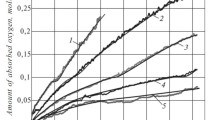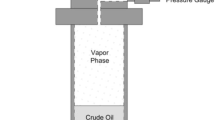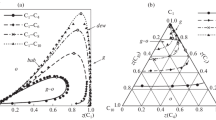It is shown that associated petroleum gas (APG) and the product of intrastratal transformation of air (by high-pressure air injection technology) are suitable for oil displacement from low-permeability, high-temperature light oil reservoirs. It was found that APG and air are effective gaseous agents miscible with oil, which are similar in oil-displacing properties. The minimum miscibility pressure (MMP) determination data are presented for an Upper Jurassic oil-APG system. The miscibility in the oil-APG system was achieved by the multicontact mechanism of interaction between oil and enriched gas. A new method is proposed for graphical determination of MMP as a function of gas breakthrough due to pressure, and a method for enhancing gas impact efficiency and for achieving miscibility at a pressure below the MMP, which consists in injection of a liquefied gas prefringe or a wide fraction of hydrocarbons, is validated.


Similar content being viewed by others
Change history
20 November 2018
There is an error in the article metadata on SpringerLink, the first author's name is incorrect. It should read P. A. Gushchin.
References
F. I. Stalkup, Miscible Displacement, Society of Petroleum Engineers AIME, 1984, p. 164.
L. W. Lake, Enhanced Oil Recovery, Prentice Hall Publ., Englewood Cliffs, New Jersey (1989), p 550.
W. F. Yelling and R. S. Metcalfe, J. Petrol. Technol., 32, No. 1,1601-1668 (1980).
V. B. Gubanov, Peculiarities of Oil Displacement by Carbon Dioxide in Presence of Mass Transfer Between Gases [in Russian], Candidate's dissertation, VNIIIneft, Moscow (1986).
A. M. Petrakov, Yu. A. Egorov, I. A. Lebedev, et al., Neft. khorz., No. 2, 604406 (2016).
G G. Vakhitov, V. G Skripka, A. A. Fatbilin, et al., Ntritepromyst Delo i Transport, No. 1, 131-136 (1985).
V. N. Khlebnikov, A. M. Polishchuk, and V. B. Gubanov, Nefispromyst Delo i Transport, No. 5, 192-194 (2014).
V. N. Khlebnikov, A. M. Polishchuk, and V. B. Gubanov, Nefiepromysl. Delo i Transport, No. 6, 323-328 (2014).
V. N. Khlebnikov, A. M. Polishchuk, and V. B. Gubanov,Nefiepromyst Delo i Transport, No. 9, 434-437 (2014).
M. Lyan, Physical Modeling of Oil Displacement by Gas (Solvent) Using Core Reservoir Models and Slim Tube [in Russian], Candidate's dissertation, IPNG, Moscow (2017).
I. Z. Mukhametzyanov and N. G. Glavnov, in: Abstracts ofPapers at X71 All-Russia Sci.-Tech. Conf. "Current Problems of Development of Oil-Gas Complex of Russia [in Russian], I. M. Gubkin Russian State University of Oil and Gas, Moscow (2018), P. 97.
V. N. Khlebnikov, S. V. Antonov, I. V. Khamidullina, et al., J. Petrochem. Univ., 29, No. 5, 263-267 (2016).
D. V. Yannimaras, A. H. Sufi, and M. R. Fassihi, "The case for air injection into deep light oil reservoirs," Proc. 6 th Europ. IOR Symp., Stavanger, Norway, 212-213 (1991).
R G. Barzin, S.A. Moore, M. G. Mehta, et al., SPE, 129691 (2010).
V. K. Kumar, C. Gutierrez, and C. Cantrell, "30 years of successful high-pressure air injection: performance evaluation of Buffalo field, South Dakota," SPE, 133494.
A. A. Bokserman and M. F. Yambaev, Collec. Paps. 12 th Europ. Symp. Enhancing Oil Recovery [in Russian], Kazan, Russia (2003).
M. F. Yambaev, Basic Characteristics of Thermal Gas Method of Increasing Oil Recovery with Reference to Conditions of Complexly Built Reservoirs (Based on Numerical Modeling) [in Russian], Candidate's dissertation, VNIIneft, Moscow (2006).
P. A. Guschin, S. V. Antonov, A. S. Mishin, et al., Chem. Technol. Fuels and Oils, 54, No. 1, 647-651 (2018).
V. N. Khlebnikov, P. M. Zobov, S. V. Antonov, et al., Bashkir. Khim. Zh., 18, No. 4, 879-882 (2011).
V. N. Khlebnikov, A. S. Mishin, P. M. Zobov, et al., Bashkir. Khim. Zh., 19, No. 3, 121-127 (2012).
V. N. Khlebnikov, A. S. Mishin, M. Lyan, et al., Tr. RGUNgfti i Gaza im. I. M. Gubkina, No. 1, 364-366 (2016).
M. Jamiu, Ekundaayo, G. Shawket, et al., Soc, of Petrol. Engineers, 2013.
S.-T. Lee, T. P. Moulds, R. Narayanan, et al., Soc, of Petrol. Engineers, 2001
T. P. Moulds, P. L. McGuire, G R. Jerauld, et al., Soc, of Petrol. Engineers, 2003.
I. A. Iskhakov, G. Rh. Gabitov, and K. Kh. Gainullin, Neff. Khoz., No. 4, 494-495 (2003).
This study was carried out with the Government financial support through the Ministry of Education and Science of Russia (unique identifier of works (project) RFAIEF1606177(0005, Agreement No. 14.606.21.0005).
The authors of this article express their gratitude to A. G. Tel in, Ph.D. Chem., for providing data on the composition of the gaseous fluids.
Author information
Authors and Affiliations
Corresponding author
Additional information
Translated from Khimiya i Tekhnologiya Topliv i Masel, No. 4, pp. 42 – 47, July – August, 2018.
Rights and permissions
About this article
Cite this article
Gushchinu, P.A., Cheremisin, A.N., Glavnov, N.G. et al. Mechanisms of Mass Exchange Between Light Oiland Petroleum Gas in Low-Permeability Reservoir Development Process. Chem Technol Fuels Oils 54, 457–466 (2018). https://doi.org/10.1007/s10553-018-0947-2
Published:
Issue Date:
DOI: https://doi.org/10.1007/s10553-018-0947-2




